Geochemistry of the Dust Collected by Passive Samplers as a Tool for Search of Pollution Sources: The Case of Klaipėda Port, Lithuania
Abstract
1. Introduction
2. Materials and Methods
2.1. Study Design
- (a)
- Selection of sampling method of total suspended particles (TSP), samplers, sampling periods, and sampling sites for permanent sampling campaign and extra more dense sampling in sites which are close to iron ore stevedoring (at <1 km distance);
- (b)
- Sampling of characteristic dust (CD) near the sites of stevedoring particular products. The aim was to obtain information about geochemical composition of products as possible emission sources;
- (c)
- Analysis of real total contents of selected analytes by EDXRF in accumulated TSP as well as CD, characterizing particular stevedored products;
- (d)
- Treatment of results by two multivariate statistical methods, i.e., principal component analysis (PCA) and cluster analysis. The tasks were to distinguish specific closely related groups of analytes, to speculate about their possible emission sources basing on findings of other publications, and to compose a list of presumable emission sources for final comparison with real spread of analytes which will be revealed in the last step h via geochemical mapping;
- (e)
- General ambient air state assessment in Klaipėda with the help geochemical indices (gI) widely used by other researchers in particulate matter (dust) studies. The intention was to find out the possibility of their comparison with respective results of other researchers as well as the usefulness and meaning of their application;
- (f)
- Assessment of temporal variability of the analyte contents during four sampling periods (P1, P2, P3, P4). The purpose was to find out with the help of Friedman ANOVA test the elements which are significantly variable;
- (g)
- Statistical comparison of gI values in two areas of the city (using nonparametric Mann–Whitney U test): the <1 km area which is close to Fe ore stevedoring and the >1 km area which includes the rest part of the city. The goals were to find out the analytes which have significantly different values in these two areas;
- (h)
- Mapping of gI values. The purpose was to compare maps with interpretation of multivariate statistical analysis results and data of characteristic dust and to draw conclusions about the reasons of pollutant anomalies.
2.2. Study Area
2.3. Sample Collection
2.4. Analysis
2.5. Geochemical Indices
2.6. Data Treatment and Statistical Analysis
3. Results
3.1. Reasons of Artificial Passive Samplers Selection
3.2. Main Geochemical Characteristics of Dust
3.3. Our Elemental Contents and the Published Data
3.4. Factor Analysis and Clustering of Complete Datasets
4. Discussion
4.1. Geochemical Indices and So-Called Contamination Classes
4.2. Weather Changes as a Factor of Dust Elemental Contamination Variability
4.3. Inter-Elemental Relationship and Related Groups
4.4. Differences in Geochemical Pattern of the City Areas
4.5. Tracing of Contamination Hotspots and Presumable Emission Sources via Mapping of gI Values
5. Conclusions
Supplementary Materials
Author Contributions
Funding
Institutional Review Board Statement
Informed Consent Statement
Data Availability Statement
Acknowledgments
Conflicts of Interest
References
- Lequy, E.; Siemiatycki, J.; Leblond, S.; Meyer, C.; Zhivin, S.; Vienneau, D.; de Hoogh, K.; Goldberg, M.; Zins, M.; Jacquemin, B. Long-term exposure to atmospheric metals assessed by mosses and mortality in France. Environ. Int. 2019, 129, 145–153. [Google Scholar] [CrossRef] [PubMed]
- Canha, N.; Almeida, M.; Do Carmo Freitas, M.; Almeida, S.M.; Wolterbeek, H.T. Seasonal variation of total particulate matter and children respiratory diseases at Lisbon primary schools using passive methods. Procedia Environ. Sci. 2011, 4, 170–183. [Google Scholar] [CrossRef]
- Rahman, M.S.; Bhuiyan, S.S.; Ahmed, Z.; Saha, N.; Begum, B.A. Characterization and source apportionment of elemental species in PM2.5 with especial emphasis on seasonal variation in the capital city “Dhaka”, Bangladesh. Urban Clim. 2021, 36, 100804. [Google Scholar] [CrossRef]
- Lin, Y.-C.; Hsu, S.-C.; Lin, S.-H.; Huang, Y.-T. Metallic elements emitted from industrial sources in Taiwan: Implications for source identification using airborne PM. Atmos. Pollut. Res. 2020, 11, 766–775. [Google Scholar] [CrossRef]
- Abbasi, S.; Keshavarzi, B.; Moore, F.; Hopke, P.K.; Kelly, F.J.; Dominguez, A.O. Elemental and magnetic analyses, source identification, and oxidative potential of airborne, passive, and street dust particles in Asaluyeh County, Iran. Sci. Total Environ. 2020, 707, 136132. [Google Scholar] [CrossRef]
- Zhao, J.; Zhang, Y.; Wang, T.; Sun, L.; Yang, Z.; Lin, Y.; Chen, Y.; Mao, H. Characterization of PM 2.5 -bound polycyclic aromatic hydrocarbons and their derivatives (nitro-and oxy-PAHs) emissions from two ship engines under different operating conditions. Chemosphere 2019, 225, 43–52. [Google Scholar] [CrossRef]
- Wen, J.; Wang, X.; Zhang, Y.; Zhu, H.; Chen, Q.; Tian, Y.; Shi, X.; Shi, G.; Feng, Y. PM2.5 source profiles and relative heavy metal risk of ship emissions: Source samples from diverse ships, engines, and navigation processes. Atmos. Environ. 2018, 191, 55–63. [Google Scholar] [CrossRef]
- Amato, F.; Pandolfi, M.; Moreno, T.; Furger, M.; Pey, J.; Alastuey, A.; Bukowiecki, N.; Prevot, A.S.H.; Baltensperger, U.; Querol, X. Sources and variability of inhalable road dust particles in three European cities. Atmos. Environ. 2011, 45, 6777–6787. [Google Scholar] [CrossRef]
- Shen, J.; Feng, X.; Zhuang, K.; Lin, T.; Zhang, Y.; Wang, P. Vertical Distribution of Particulates within the Near-Surface Layer of Dry Bulk Port and Influence Mechanism: A Case Study in China. Sustainability 2019, 11, 7135. [Google Scholar] [CrossRef]
- EEA. EMEP/EEA Air Pollutant Emission Inventory Guidebook 2019 2.A.5.c Storage, Handling and Transport of Mineral Products; Publications Office of the European Union: Luxembourg, 2019; ISBN 978-92-9480-098-5.
- Tume, P.; King, R.; González, E.; Bustamante, G.; Reverter, F.; Roca, N.; Bech, J. Trace element concentrations in schoolyard soils from the port city of Talcahuano, Chile. J. Geochem. Explor. 2014, 147, 229–236. [Google Scholar] [CrossRef]
- Davuliene, L.; Jasineviciene, D.; Garbariene, I.; Andriejauskiene, J.; Ulevicius, V.; Bycenkiene, S. Long-term air pollution trend analysis in the South-eastern Baltic region, 1981–2017. Atmos. Res. 2021, 247, 105191. [Google Scholar] [CrossRef]
- Zhao, L.; Wang, L.; Tan, J.; Duan, J.; Ma, X.; Zhang, C.; Ji, S.; Qi, M.; Lu, X.H.; Wang, Y.; et al. Changes of chemical composition and source apportionment of PM 2.5 during 2013–2017 in urban Handan, China. Atmos. Environ. 2019, 206, 119–131. [Google Scholar] [CrossRef]
- Taraškevičius, R.; Motiejūnaitė, J.; Zinkutė, R.; Eigminienė, A.; Gedminienė, L.; Stankevičius, Ž. Similarities and differences in geochemical distribution patterns in epiphytic lichens and topsoils from kindergarten grounds in Vilnius. J. Geochem. Explor. 2017, 183, 152–165. [Google Scholar] [CrossRef]
- Taraškevičius, R.; Zinkutė, R.; Gedminienė, L.; Stankevičius, Ž. Hair geochemical composition of children from Vilnius kindergartens as an indicator of environmental conditions. Environ. Geochem. Health 2018, 40, 1817–1840. [Google Scholar] [CrossRef]
- Baltrenas, P.; Fröhner, K.D.; Pranskevičius, M. Investigation of seaport air dustiness and dust spread. J. Environ. Eng. Landsc. Manag. 2007, 15, 15–23. [Google Scholar] [CrossRef]
- Baltrenas, P.; Kvasauskas, M.; Frohner, K.D. Influence of stevedoring operations of liquid and powdery fertilizers at klaipeda state seaport on the ambient air quality. J. Environ. Eng. Landsc. Manag. 2006, 14, 59–68. [Google Scholar] [CrossRef]
- Zhao, M.; Zhang, Y.; Ma, W.; Fu, Q.; Yang, X.; Li, C.; Zhou, B.; Yu, Q.; Chen, L. Characteristics and ship traffic source identification of air pollutants in China’s largest port. Atmos. Environ. 2013, 64, 277–286. [Google Scholar] [CrossRef]
- Taraškevičius, R. Klaipėdos Miesto Ikimokyklinių Įstaigų, Rekreacinių Ir Visuomeninių Teritorijų Dirvožemio Geocheminė Sudėtis Ir Bendras Miesto Teritorijos Ekogeocheminis Vertinimas (Pagal 2006 Ir 2007 M. Tyrimo Rezultatus) Sudarant Žemėlapius. Available online: http://www.monitor.ku.lt/doc/0%20Virselis%202007.pdf (accessed on 10 August 2021).
- Milinis, M. Klaipėdiečių Kantrybė Trūko: Juodos Dulkės Skverbiasi į Būstus, Vaikai Ėmė Kosėti. Available online: https://www.delfi.lt/verslas/verslas/klaipedieciu-kantrybe-truko-juodos-dulkes-skverbiasi-i-bustus-vaikai-eme-koseti.d?id=78829483 (accessed on 12 September 2021).
- Taraškevičius, R.; Gulbinskas, S. Pedogeochemical accumulating associations of education and learning institutions and sport stadiums in Klaipeda. In Proceedings of the 15th International Conference on Heavy Metals in the Environment, Gdańsk, Poland, 19–23 September 2010; Department of Analytical Chemistry, Chemical Faculty: Gdansk, Poland, 2010; pp. 781–784. [Google Scholar]
- Gaidelys, V.; Benetyte, R. Analysis of the Competitiveness of the Performance of Baltic Ports in the Context of Economic Sustainability. Sustainability 2021, 13, 3267. [Google Scholar] [CrossRef]
- Climate Data. Available online: https://en.climate-data.org/europe/lithuania/klaipeda-county/klaipeda-432/ (accessed on 21 August 2021).
- Bitinas, A.; Damušyte, A. The littorina sea at the Lithuanian maritime region. Pol. Geol. Inst. Spec. Pap. 2004, 11, 37–46. [Google Scholar]
- Zinkutė, R.; Taraškevičius, R.; Jankauskaitė, M.; Stankevičius, Ž. Methodological alternatives for calculation of enrichment factors used for assessment of topsoil contamination. J. Soils Sediments 2017, 17, 440–452. [Google Scholar] [CrossRef]
- Air Quality. Available online: https://aaa.lrv.lt/lt/veiklos-sritys/oras/oro-kokybes-statistika-ir-duomenys/metu-oro-kokybes-rodikliai (accessed on 15 May 2021).
- Van Dijk, D. Wageningen Evaluating Programmes for Analytical Laboratories (Wepal): A World of Experience. Commun. Soil Sci. Plant Anal. 2002, 33, 2457–2465. [Google Scholar] [CrossRef]
- Schramm, R.; Heckel, J. Fast analysis of traces and major elements with ED(P)XRF using polarized X-rays: TURBOQUANT. J. Phys. IV 1998, 8, Pr5-335–Pr5-342. [Google Scholar] [CrossRef]
- Introducing a New Era in Analytical Performance. Available online: https://www.spectro.com/products/xrf-spectrometer/xepos-xrf-spectrometer (accessed on 15 May 2021).
- Analyzing Trace Elements in Pressed Pellets of Geological Materials Using ED-XRF. Available online: https://extranet.spectro.com/-/media/5C512E72-682D-45D8-AE56-6740529341BC.pdf (accessed on 17 November 2021).
- Taraškevičius, R.; Zinkutė, R.; Stakėnienė, R.; Radavičius, M. Case Study of the Relationship between Aqua Regia and Real Total Contents of Harmful Trace Elements in Some European Soils. J. Chem. 2013, 2013, 678140. [Google Scholar] [CrossRef]
- Rudnick, R.L.; Gao, S. Composition of the Continental Crust. In Treatise on Geochemistry; Elsevier: Amsterdam, The Netherlands, 2003; pp. 1–64. [Google Scholar]
- Muller, G. Schwermetalle in den sediments des Rheins-Veranderungen Seitt. Umschan 1979, 79, 778–783. [Google Scholar]
- Sager, M.; Chon, H.-T.; Marton, L. Spatial variation of contaminant elements of roadside dust samples from Budapest (Hungary) and Seoul (Republic of Korea), including Pt, Pd and Ir. Environ. Geochem. Health 2015, 37, 181–193. [Google Scholar] [CrossRef]
- Alves, C.A.; Vicente, E.D.; Vicente, A.M.P.; Rienda, I.C.; Tomé, M.; Querol, X.; Amato, F. Loadings, chemical patterns and risks of inhalable road dust particles in an Atlantic city in the north of Portugal. Sci. Total Environ. 2020, 737, 139596. [Google Scholar] [CrossRef]
- Dytłow, S.; Górka-Kostrubiec, B. Concentration of heavy metals in street dust: An implication of using different geochemical background data in estimating the level of heavy metal pollution. Environ. Geochem. Health 2021, 43, 521–535. [Google Scholar] [CrossRef]
- Chen, L.; Zhou, S.; Wu, S.; Wang, C.; He, D. Concentration, fluxes, risks, and sources of heavy metals in atmospheric deposition in the Lihe River watershed, Taihu region, eastern China. Environ. Pollut. 2019, 255, 113301. [Google Scholar] [CrossRef]
- Förstner, U.; Müller, G. Concentrations of heavy metals and polycyclic aromatic hydrocarbons in river sediments: Geochemical background, man’s influence and environmental impact. GeoJournal 1981, 5, 417–432. [Google Scholar] [CrossRef]
- Rahn, K.A. Sources of Trace Elements in Aerosols: An Approach to Clean Air; U.S. Atomic Energy Commission: Washington, DC, USA, 1971. [Google Scholar] [CrossRef]
- Cesari, D.; Contini, D.; Genga, A.; Siciliano, M.; Elefante, C.; Baglivi, F.; Daniele, L. Analysis of raw soils and their re-suspended PM10 fractions: Characterisation of source profiles and enrichment factors. Appl. Geochem. 2012, 27, 1238–1246. [Google Scholar] [CrossRef]
- Megido, L.; Negral, L.; Castrillón, L.; Suárez-Peña, B.; Fernández-Nava, Y.; Marañón, E. Enrichment factors to assess the anthropogenic influence on PM10 in Gijón (Spain). Environ. Sci. Pollut. Res. 2017, 24, 711–724. [Google Scholar] [CrossRef] [PubMed]
- Švédová, B.; Matýsek, D.; Raclavská, H.; Kucbel, M.; Kantor, P.; Šafář, M.; Raclavský, K. Variation of the chemical composition of street dust in a highly industrialized city in the interval of ten years. J. Environ. Manag. 2020, 267, 110506. [Google Scholar] [CrossRef] [PubMed]
- Marín Sanleandro, P.; Sánchez Navarro, A.; Díaz-Pereira, E.; Bautista Zuñiga, F.; Romero Muñoz, M.; Delgado Iniesta, M.J. Assessment of heavy metals and color as indicators of contamination in street dust of a city in SE Spain: Influence of traffic intensity and sampling location. Sustainability 2018, 10, 4105. [Google Scholar] [CrossRef]
- Zgłobicki, W.; Telecka, M.; Skupiński, S.; Pasierbińska, A.; Kozieł, M. Assessment of heavy metal contamination levels of street dust in the city of Lublin, E Poland. Environ. Earth Sci. 2018, 77, 774. [Google Scholar] [CrossRef]
- Vlasov, D.; Kosheleva, N.; Kasimov, N. Spatial distribution and sources of potentially toxic elements in road dust and its PM10 fraction of Moscow megacity. Sci. Total Environ. 2020, 5, 143267. [Google Scholar] [CrossRef]
- Shi, D.; Lu, X. Accumulation degree and source apportionment of trace metals in smaller than 63 μm road dust from the areas with different land uses: A case study of Xi’an, China. Sci. Total Environ. 2018, 636, 1211–1218. [Google Scholar] [CrossRef]
- Wang, Q.; Lu, X.; Pan, H. Analysis of heavy metals in the re-suspended road dusts from different functional areas in Xi’an, China. Environ. Sci. Pollut. Res. 2016, 23, 19838–19846. [Google Scholar] [CrossRef]
- Gregorauskienė, V.; Taraškevičius, R.; Kadūnas, V.; Radzevičius, A.; Zinkutė, R. Geochemical Characteristics of Lithuanian Urban Areas. In Mapping the Chemical Environment of Urban Areas; John Wiley & Sons, Ltd.: Chichester, UK, 2011; pp. 393–409. [Google Scholar]
- Kumpiene, J.; Brännvall, E.; Taraškevičius, R.; Aksamitauskas, Č.; Zinkutė, R. Spatial variability of topsoil contamination with trace elements in preschools in Vilnius, Lithuania. J. Geochem. Explor. 2011, 108, 15–20. [Google Scholar] [CrossRef]
- Sajet, J. Geokimija Okrushajuchei Sredi (Environmental Geochemistry); Nedra: Moscow, Russia, 1990. [Google Scholar]
- Naraki, H.; Keshavarzi, B.; Zarei, M.; Moore, F.; Abbasi, S.; Kelly, F.J.; Dominguez, A.O.; Jaafarzadeh, N. Urban street dust in the Middle East oldest oil refinery zone: Oxidative potential, source apportionment and health risk assessment of potentially toxic elements. Chemosphere 2021, 268, 128825. [Google Scholar] [CrossRef]
- Hakanson, L. An ecological risk index for aquatic pollution control.a sedimentological approach. Water Res. 1980, 14, 975–1001. [Google Scholar] [CrossRef]
- Rincheval, M.; Cohen, D.R.; Hemmings, F.A. Biogeochemical mapping of metal contamination from mine tailings using field-portable XRF. Sci. Total Environ. 2019, 662, 404–413. [Google Scholar] [CrossRef]
- Castanheiro, A.; Hofman, J.; Nuyts, G.; Joosen, S.; Spassov, S.; Blust, R.; Lenaerts, S.; De Wael, K.; Samson, R. Leaf accumulation of atmospheric dust: Biomagnetic, morphological and elemental evaluation using SEM, ED-XRF and HR-ICP-MS. Atmos. Environ. 2020, 221, 117082. [Google Scholar] [CrossRef]
- Peng, L.; Li, X.; Sun, X.; Yang, T.; Zhang, Y.; Gao, Y.; Zhang, X.; Zhao, Y.; He, A.; Zhou, M.; et al. Comprehensive Urumqi screening for potentially toxic metals in soil-dust-plant total environment and evaluation of children’s (0–6 years) risk-based blood lead levels prediction. Chemosphere 2020, 258, 127342. [Google Scholar] [CrossRef]
- Huang, J.; Wu, G.; Zhang, X.; Zhang, C. New insights into particle-bound trace elements in surface snow, Eastern Tien Shan, China. Environ. Pollut. 2020, 267, 115272. [Google Scholar] [CrossRef]
- Kasimov, N.S.; Vlasov, D.V.; Kosheleva, N.E. Enrichment of road dust particles and adjacent environments with metals and metalloids in eastern Moscow. Urban Clim. 2020, 32, 100638. [Google Scholar] [CrossRef]
- Talovskaya, A.V.; Yazikov, E.G.; Osipova, N.A.; Lyapina, E.E.; Litay, V.V.; Metreveli, G.; Kim, J. Mercury Pollution In Snow Cover Around Thermal Power Plants In Cities (Omsk, Kemerovo, Tomsk Regions, Russia). Geogr. Environ. Sustain. 2019, 12, 132–147. [Google Scholar] [CrossRef][Green Version]
- Fujiwara, F.; Rebagliati, R.J.; Marrero, J.; Gómez, D.; Smichowski, P. Antimony as a traffic-related element in size-fractionated road dust samples collected in Buenos Aires. Microchem. J. 2011, 97, 62–67. [Google Scholar] [CrossRef]
- Kariper, A.; Üstündağ, İ.; Deniz, K.; Mülazımoğlu, İ.E.; Erdoğan, M.S.; Kadıoğlu, Y.K. Elemental monitoring of street dusts in Konya in Turkey. Microchem. J. 2019, 148, 338–345. [Google Scholar] [CrossRef]
- Koh, B.; Kim, E.A. Comparative analysis of urban road dust compositions in relation to their potential human health impacts. Environ. Pollut. 2019, 255, 113156. [Google Scholar] [CrossRef]
- Kolakkandi, V.; Sharma, B.; Rana, A.; Dey, S.; Rawat, P.; Sarkar, S. Spatially resolved distribution, sources and health risks of heavy metals in size-fractionated road dust from 57 sites across megacity Kolkata, India. Sci. Total Environ. 2020, 705, 135805. [Google Scholar] [CrossRef]
- Lanzerstorfer, C.; Logiewa, A. The upper size limit of the dust samples in road dust heavy metal studies: Benefits of a combined sieving and air classification sample preparation procedure. Environ. Pollut. 2019, 245, 1079–1085. [Google Scholar] [CrossRef]
- Urrutia-Goyes, R.; Hernandez, N.; Carrillo-Gamboa, O.; Nigam, K.D.P.; Ornelas-Soto, N. Street dust from a heavily-populated and industrialized city: Evaluation of spatial distribution, origins, pollution, ecological risks and human health repercussions. Ecotoxicol. Environ. Saf. 2018, 159, 198–204. [Google Scholar] [CrossRef]
- Cao, L.; Appel, E.; Hu, S.; Ma, M. An economic passive sampling method to detect particulate pollutants using magnetic measurements. Environ. Pollut. 2015, 205, 97–102. [Google Scholar] [CrossRef]
- Luo, N.; An, L.; Nara, A.; Yan, X.; Zhao, W. GIS-based multielement source analysis of dustfall in Beijing: A study of 40 major and trace elements. Chemosphere 2016, 152, 123–131. [Google Scholar] [CrossRef]
- Wang, J.; Zhang, X.; Yang, Q.; Zhang, K.; Zheng, Y.; Zhou, G. Pollution characteristics of atmospheric dustfall and heavy metals in a typical inland heavy industry city in China. J. Environ. Sci. 2018, 71, 283–291. [Google Scholar] [CrossRef]
- Willem Erisman, J.A.N.; Beier, C.; Draaijers, G.; Lindberg, S. Review of deposition monitoring methods. Tellus B Chem. Phys. Meteorol. 1994, 46, 79–93. [Google Scholar] [CrossRef]
- Assael, M.J.; Melas, D.; Kakosimos, K.E. Monitoring particulate matter concentrations with passive samplers: Application to the Greater Thessaloniki area. Water Air Soil Pollut. 2010, 211, 395–408. [Google Scholar] [CrossRef]
- Abdulaziz, K.; Al-Nadji, K.; Kadri, A.; Kakosimos, K. Airborne particulate matter passive samplers for indoor and outdoor exposure monitoring: Development and Evaluation. In Proceedings of the XIII International Conference on Air Pollution and Control, Paris, France, February 2015; Available online: https://www.researchgate.net/publication/320015014_Airborne_Particulate_Matter_Passive_Samplers_for_Indoor_and_Outdoor_Exposure_Monitoring_Development_and_Evaluation (accessed on 12 September 2021).
- García-Florentino, C.; Maguregui, M.; Carrero, J.A.; Morillas, H.; Arana, G.; Madariaga, J.M. Development of a cost effective passive sampler to quantify the particulate matter depositions on building materials over time. J. Clean. Prod. 2020, 268, 122134. [Google Scholar] [CrossRef]
- Clarke, F.W. The Relative Abundance of the Chemical Elements. Bull. Philos. Soc. Wash. 1889, 11, 135–143. [Google Scholar]
- Soltani, N.; Keshavarzi, B.; Moore, F.; Cave, M.; Sorooshian, A.; Mahmoudi, M.R.; Ahmadi, M.R.; Golshani, R. In vitro bioaccessibility, phase partitioning, and health risk of potentially toxic elements in dust of an iron mining and industrial complex. Ecotoxicol. Environ. Saf. 2021, 212, 111972. [Google Scholar] [CrossRef]
- Vehlow, J.; Bergfeldt, B.; Hunsinger, H.; Scifert, H.; Mark, F.E. Bromine in waste incineration partitioning and influence on metal volatilisation. Environ. Sci. Pollut. Res. 2003, 10, 329–334. [Google Scholar] [CrossRef] [PubMed]
- Banerjee, A.D.K. Heavy metal levels and solid phase speciation in street dusts of Delhi, India. Environ. Pollut. 2003, 123, 95–105. [Google Scholar] [CrossRef]
- Yang, T.; Liu, Q.; Li, H.; Zeng, Q.; Chan, L. Anthropogenic magnetic particles and heavy metals in the road dust: Magnetic identification and its implications. Atmos. Environ. 2010, 44, 1175–1185. [Google Scholar] [CrossRef]
- Fakinle, B.S.; Uzodinma, O.B.; Odekanle, E.L.; Sonibare, J.A. Impact of elemental composition of particulate matter in the airshed of a University Farm on the local air quality. Heliyon 2020, 6, e03216. [Google Scholar] [CrossRef]
- Goel, V.; Mishra, S.K.; Pal, P.; Ahlawat, A.; Vijayan, N.; Jain, S.; Sharma, C. Influence of chemical aging on physico-chemical properties of mineral dust particles: A case study of 2016 dust storms over Delhi. Environ. Pollut. 2020, 267, 115338. [Google Scholar] [CrossRef]
- Ivošević, T.; Mandić, L.; Orlić, I.; Stelcer, E.; Cohen, D.D. Comparison between XRF and IBA techniques in analysis of fine aerosols collected in Rijeka, Croatia. Nucl. Instrum. Methods Phys. Res. Sect. B Beam Interact. Mater. Atoms 2014, 337, 83–89. [Google Scholar] [CrossRef]
- Wang, T.; Rovira, J.; Sierra, J.; Chen, S.-J.; Mai, B.-X.; Schuhmacher, M.; Domingo, J.L. Characterization and risk assessment of total suspended particles (TSP) and fine particles (PM2.5) in a rural transformational e-waste recycling region of Southern China. Sci. Total Environ. 2019, 692, 432–440. [Google Scholar] [CrossRef]
- Tang, Y.; Han, G. Characteristics of major elements and heavy metals in atmospheric dust in Beijing, China. J. Geochem. Explor. 2017, 176, 114–119. [Google Scholar] [CrossRef]
- Vercauteren, J.; Matheeussen, C.; Wauters, E.; Roekens, E.; van Grieken, R.; Krata, A.; Makarovska, Y.; Maenhaut, W.; Chi, X.; Geypens, B. Chemkar PM10: An extensive look at the local differences in chemical composition of PM10 in Flanders, Belgium. Atmos. Environ. 2011, 45, 108–116. [Google Scholar] [CrossRef]
- Samek, L.; Stegowski, Z.; Furman, L.; Fiedor, J. Chemical content and estimated sources of fine fraction of particulate matter collected in Krakow. Air Qual. Atmos. Health 2017, 10, 47–52. [Google Scholar] [CrossRef]
- Nayebare, S.R.; Aburizaiza, O.S.; Siddique, A.; Carpenter, D.O.; Hussain, M.M.; Zeb, J.; Aburiziza, A.J.; Khwaja, H.A. Ambient air quality in the holy city of Makkah: A source apportionment with elemental enrichment factors (EFs) and factor analysis (PMF). Environ. Pollut. 2018, 243, 1791–1801. [Google Scholar] [CrossRef]
- De Vos, W.; Tarvainen, T.; Salminen, R.; Reeder, S.; De Vivo, B.; Demetriades, A.; Pirc, S.; Batista, M.J.; Marsina, K.; Ottesen, R.T.; et al. Geochemical Atlas of Europe. Part 2, Interpretation of Geochemical Maps, Additional Tables, Figures, Maps, and Related Publications; Geological Survey of Finland: Espoo, Finland, 2006; ISBN 9516909566. [Google Scholar]
- Shahab, A.; Zhang, H.; Ullah, H.; Rashid, A.; Rad, S.; Li, J.; Xiao, H. Pollution characteristics and toxicity of potentially toxic elements in road dust of a tourist city, Guilin, China: Ecological and health risk assessment. Environ. Pollut. 2020, 266, 115419. [Google Scholar] [CrossRef]
- Zinkutė, R.; Taraškevičius, R.; Jankauskaitė, M.; Kazakauskas, V.; Stankevičius, Ž. Influence of site-classification approach on geochemical background values. Open Chem. 2020, 18, 1391–1411. [Google Scholar] [CrossRef]
- Reimann, C.; Caritat, P. de Intrinsic Flaws of Element Enrichment Factors (EFs) in Environmental Geochemistry. Environ. Sci. Technol. 2000, 34, 5084–5091. [Google Scholar] [CrossRef]
- Reimann, C.; de Caritat, P. Distinguishing between natural and anthropogenic sources for elements in the environment: Regional geochemical surveys versus enrichment factors. Sci. Total Environ. 2005, 337, 91–107. [Google Scholar] [CrossRef]
- Ravindra, K.; Mor, S. Variation in Spatial Pattern of Criteria Air Pollutants before and during Initial Rain of Monsoon. Environ. Monit. Assess. 2003, 87, 143–153. [Google Scholar] [CrossRef]
- Lee, D.S.; Garland, J.A.; Fox, A.A. Atmospheric concentrations of trace elements in urban areas of the United Kingdom. Atmos. Environ. 1994, 28, 2691–2713. [Google Scholar] [CrossRef]
- Kicińska, A.; Bożęcki, P. Metals and mineral phases of dusts collected in different urban parks of Krakow and their impact on the health of city residents. Environ. Geochem. Health 2018, 40, 473–488. [Google Scholar] [CrossRef]
- Gunawardana, C.; Goonetilleke, A.; Egodawatta, P.; Dawes, L.; Kokot, S. Source characterisation of road dust based on chemical and mineralogical composition. Chemosphere 2012, 87, 163–170. [Google Scholar] [CrossRef]
- Calvo, A.I.; Alves, C.; Castro, A.; Pont, V.; Vicente, A.M.; Fraile, R. Research on aerosol sources and chemical composition: Past, current and emerging issues. Atmos. Res. 2013, 120–121, 1–28. [Google Scholar] [CrossRef]
- Baltrėnas, P.; Vaišis, V. Research into soil contamination by heavy metals in the northern part of the Klaipėda city, Lithuania. Geologija 2006, 55, 1–8. [Google Scholar]
- Gregorauskienė, V.; Taraškevičius, R. Chromas Klaipėdos dirvožemyje: Kokiais metodais ir kuriose laboratorijose ieškoti. In Proceedings of the Jūros Ir Krantų Tyrimai 2020, Klaipeda, Lithuania, 7–9 October 2020; Klaipėdos Universiteto Jūros Tyrimų Institutas: Klaipeda, Lithuania, 2020; pp. 62–66. [Google Scholar]
- Carrero, J.A.; Arrizabalaga, I.; Bustamante, J.; Goienaga, N.; Arana, G.; Madariaga, J.M. Diagnosing the traffic impact on roadside soils through a multianalytical data analysis of the concentration profiles of traffic-related elements. Sci. Total Environ. 2013, 458–460, 427–434. [Google Scholar] [CrossRef]
- Caforio, A. Inquinamento atmosferico da piombo. Inquinamento 1986, 28, 54–57. [Google Scholar]
- Rakovan, J.F.; Hughes, J.M. Strontium in the Apatite Structure: Strontian Fluorapatite and Belovite-(Ce). Can. Mineral. 2000, 38, 839–845. [Google Scholar] [CrossRef]
- Kratz, S.; Schick, J.; Schnug, E. Trace elements in rock phosphates and P containing mineral and organo-mineral fertilizers sold in Germany. Sci. Total Environ. 2016, 542, 1013–1019. [Google Scholar] [CrossRef] [PubMed]
- Eurochem Lifosa. Available online: https://www.lifosa.com/en/products-services/production/167 (accessed on 24 May 2021).
- Johansson, L.; Jalkanen, J.P.; Kalli, J.; Kukkonen, J. The evolution of shipping emissions and the costs of regulation changes in the northern EU area. Atmos. Chem. Phys. 2013, 13, 11375–11389. [Google Scholar] [CrossRef]
- WSY Western Shipyard BLRT Group. Available online: https://wsy.lt/en/ (accessed on 24 May 2021).
- Raclavská, H.; Corsaro, A.; Hartmann-Koval, S.; Juchelková, D. Enrichment and distribution of 24 elements within the sub-sieve particle size distribution ranges of fly ash from wastes incinerator plants. J. Environ. Manag. 2017, 203, 1169–1177. [Google Scholar] [CrossRef] [PubMed]
- Hopke, P.K.; Dai, Q.; Li, L.; Feng, Y. Global review of recent source apportionments for airborne particulate matter. Sci. Total Environ. 2020, 740, 140091. [Google Scholar] [CrossRef]
- Sorte, S.; Rodrigues, V.; Borrego, C.; Monteiro, A. Impact of harbour activities on local air quality: A review. Environ. Pollut. 2020, 257, 113542. [Google Scholar] [CrossRef]
- Orlen Lietuva. Available online: https://www.orlenlietuva.lt/EN/Company/OL/Pages/Refinery.aspx (accessed on 24 May 2021).
- Crawford, J.; Cohen, D.D.; Chambers, S.D.; Williams, A.G.; Atanacio, A. Impact of aerosols of sea salt origin in a coastal basin: Sydney, Australia. Atmos. Environ. 2019, 207, 52–62. [Google Scholar] [CrossRef]
- Rodríguez, S.; Calzolai, G.; Chiari, M.; Nava, S.; García, M.I.; López-Solano, J.; Marrero, C.; López-Darias, J.; Cuevas, E.; Alonso-Pérez, S.; et al. Rapid changes of dust geochemistry in the Saharan Air Layer linked to sources and meteorology. Atmos. Environ. 2020, 223, 117186. [Google Scholar] [CrossRef]
- Foltescu, V.L.; Isakson, J.; Sflin, E.; Stikans, M. Measured fluxes of sulphur, chlorine and some anthropogenic metals to the Swedish west coast. Atmos. Environ. 1994, 28, 2639–2649. [Google Scholar] [CrossRef]
- Stravinskienė, V. Pollution of “akmenės cementas” vicinity: Alkalizing microelements in soil, composition of vegetation species and projection coverage/”akmenės cemento“ aplinkos tarša. Dirvožemį šarminantys mikroelementai, augalijos rūšių į vairovė ir projekcinis padeng. J. Environ. Eng. Landsc. Manag. 2011, 19, 130–139. [Google Scholar] [CrossRef]
- Stančikaitė, M.; Bliujienė, A.; Kisielienė, D.; Mažeika, J.; Taraškevičius, R.; Messal, S.; Szwarczewski, P.; Kusiak, J.; Stakėnienė, R. Population history and palaeoenvironment in the Skomantai archaeological site, West Lithuania: Two thousand years. Quat. Int. 2013, 308–309, 190–204. [Google Scholar] [CrossRef]
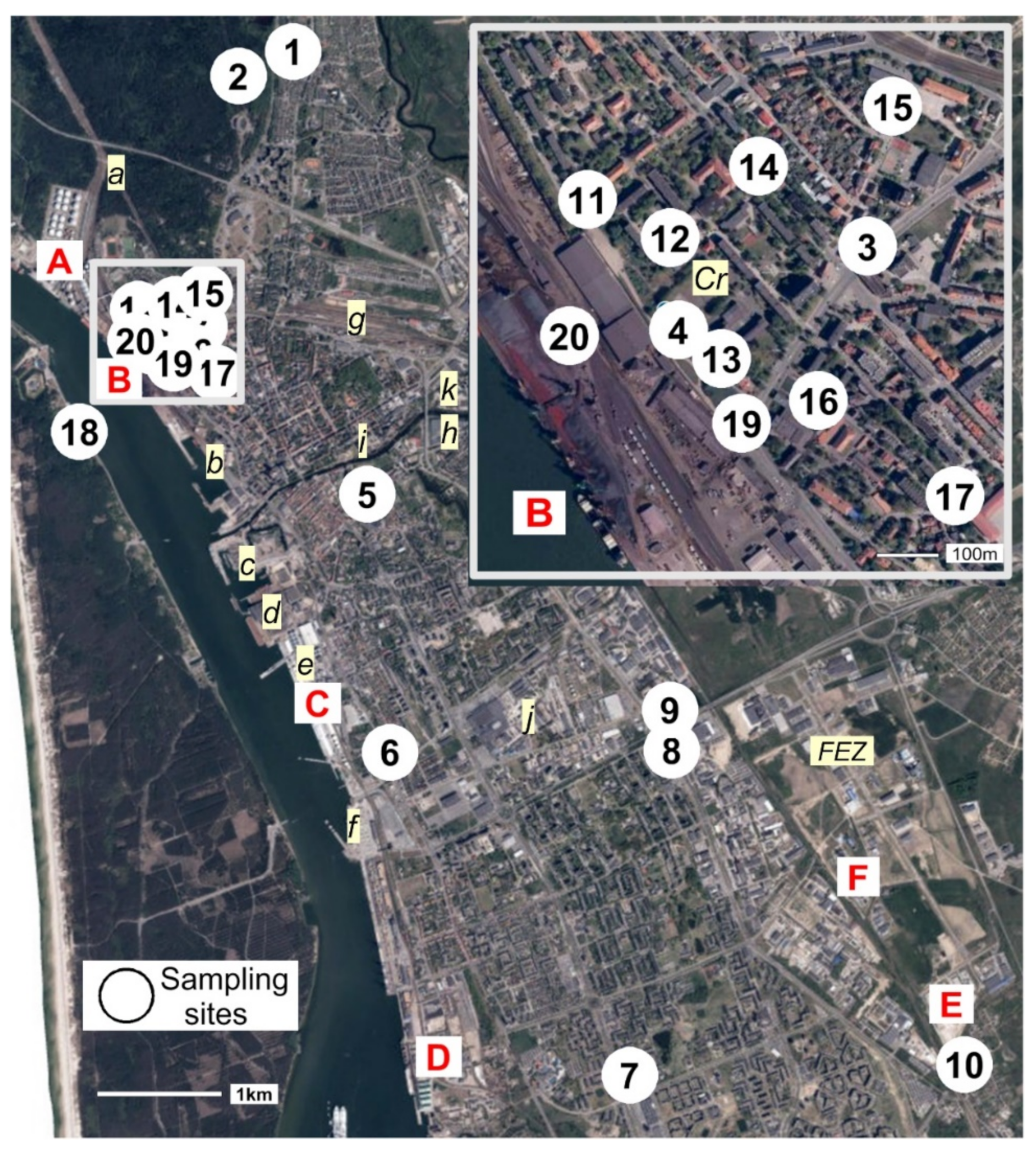
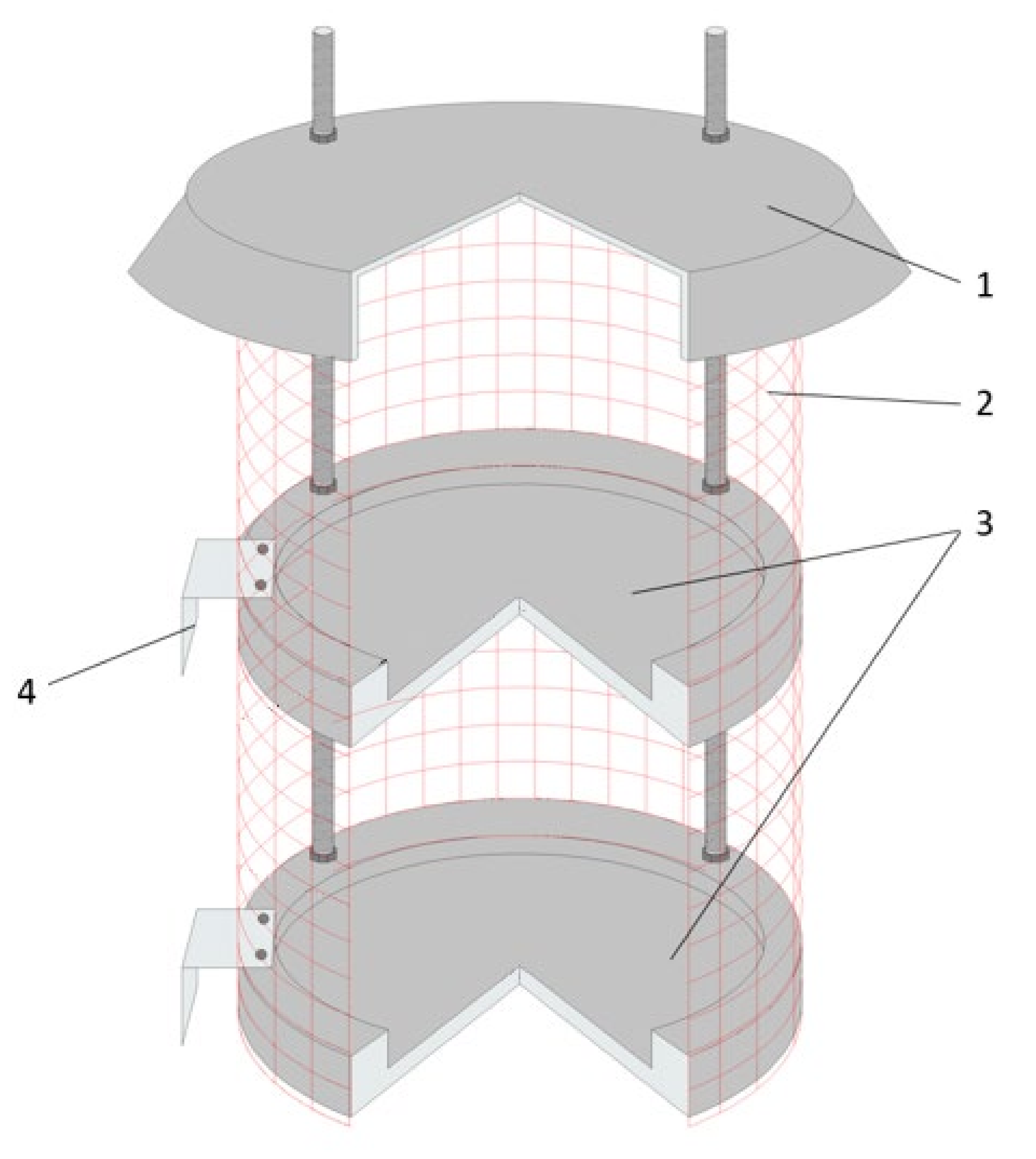
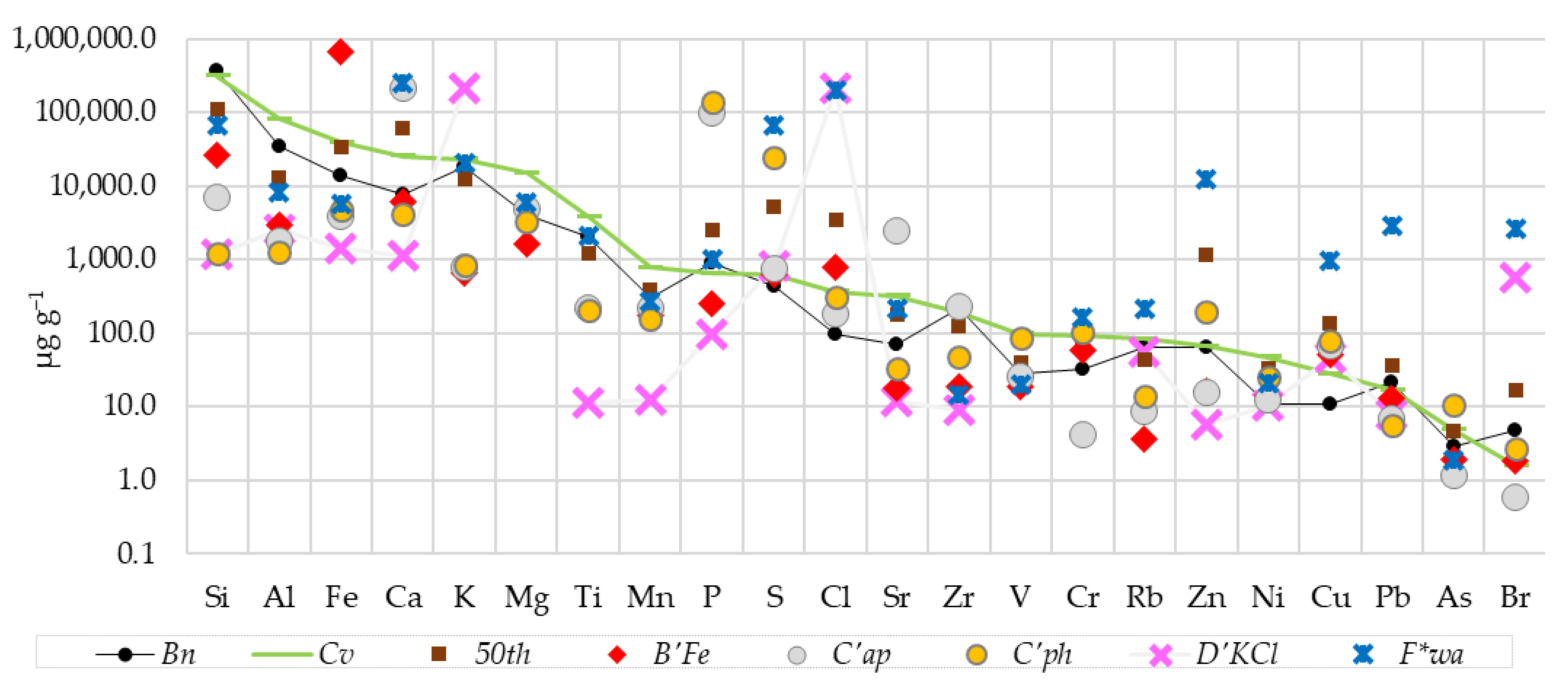
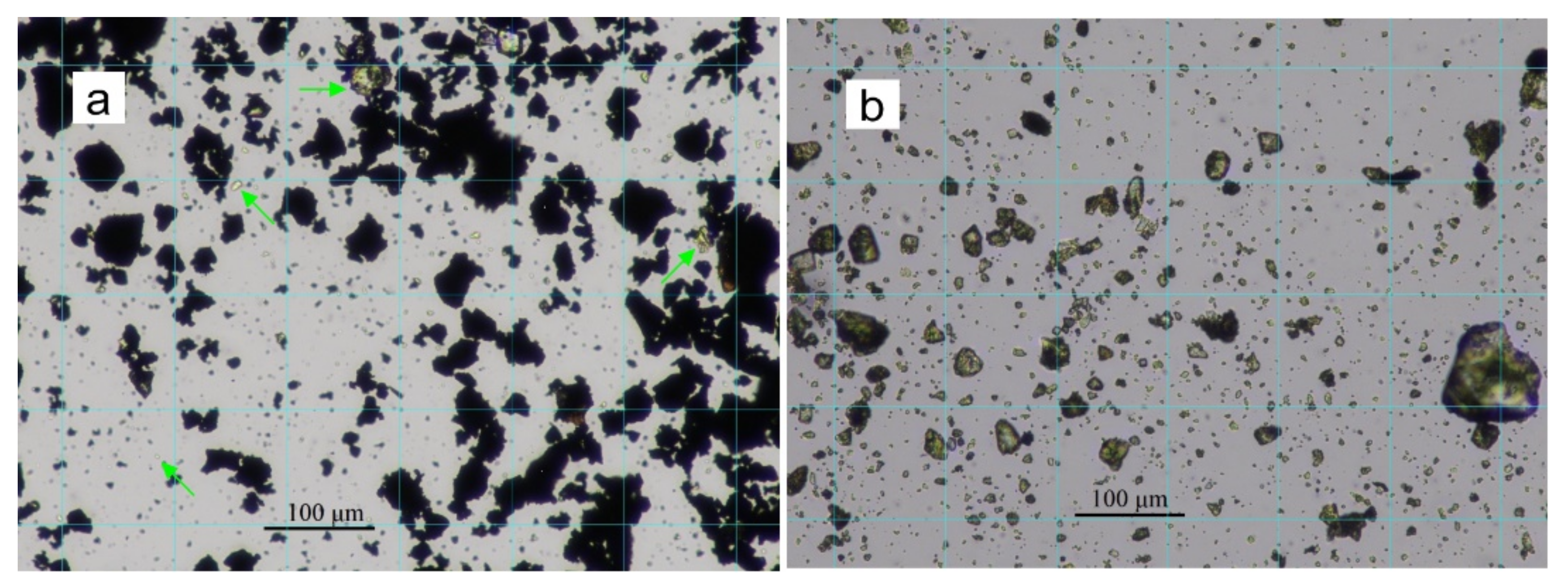
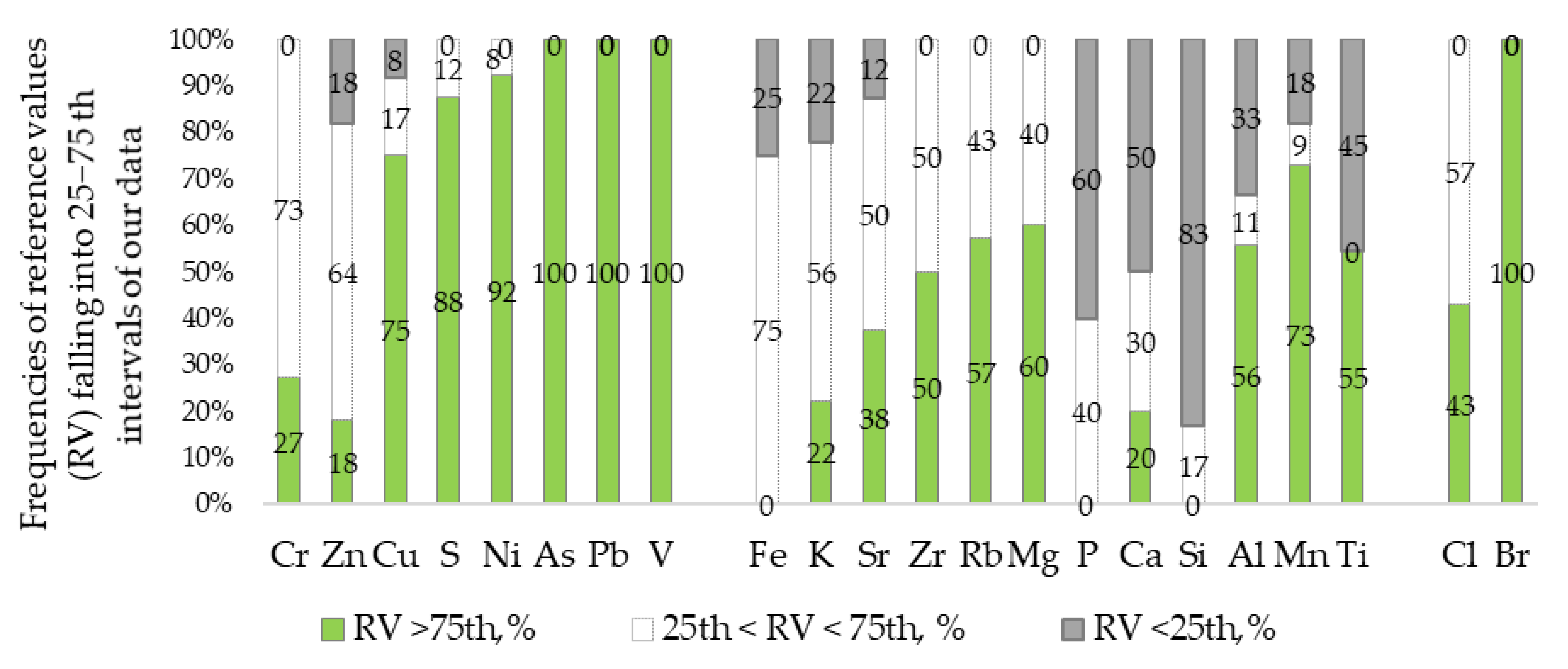
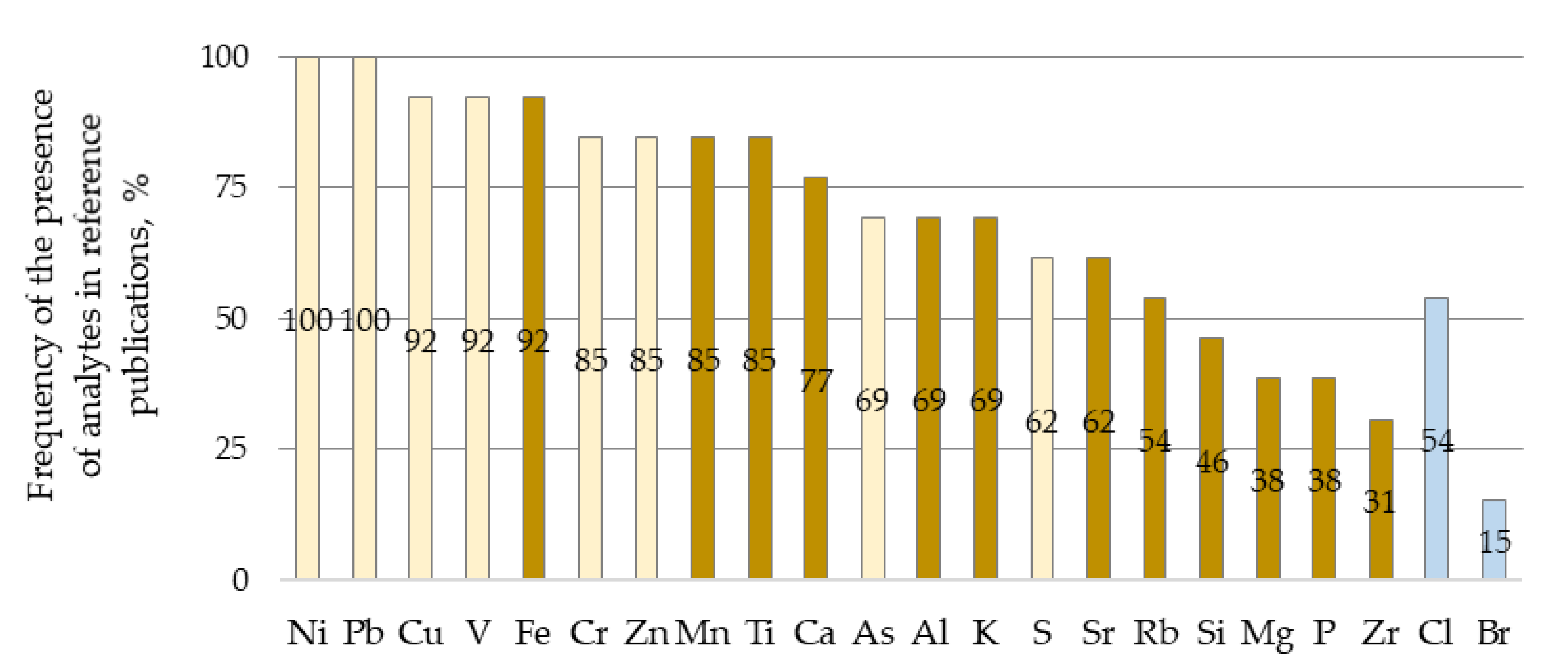
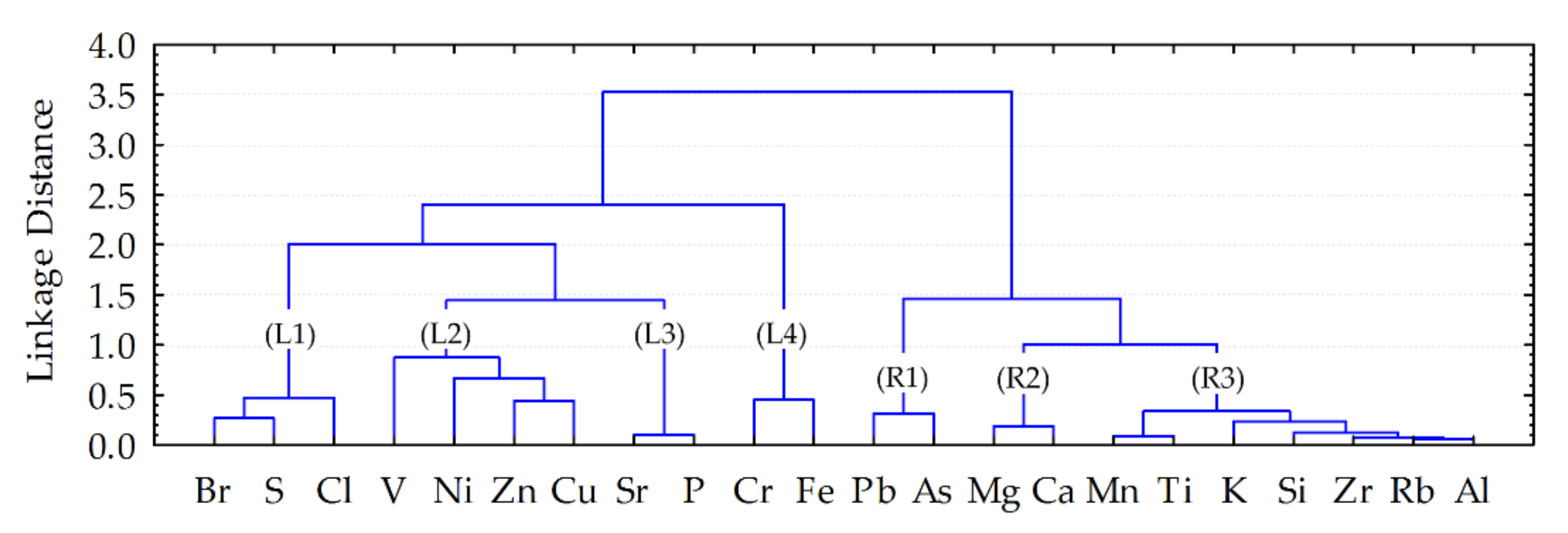
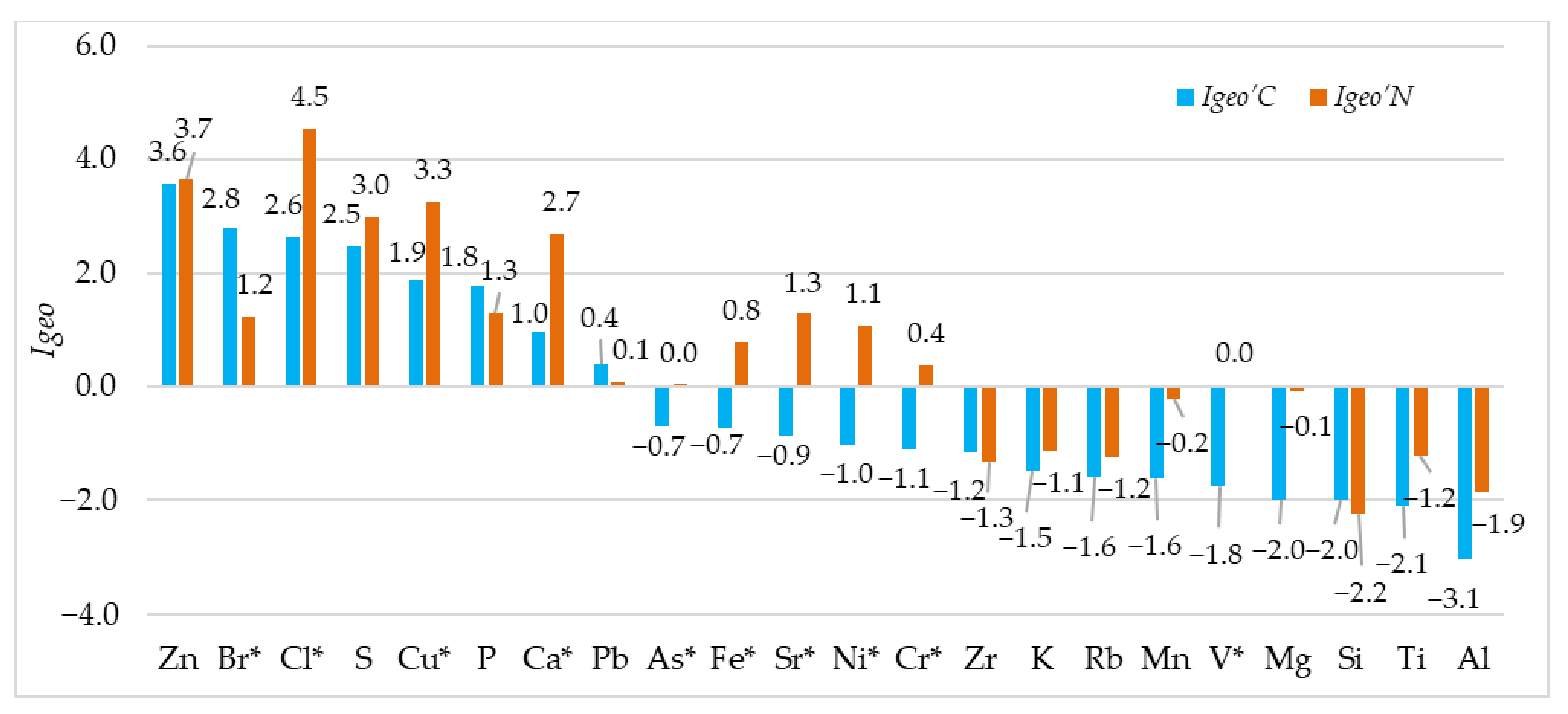
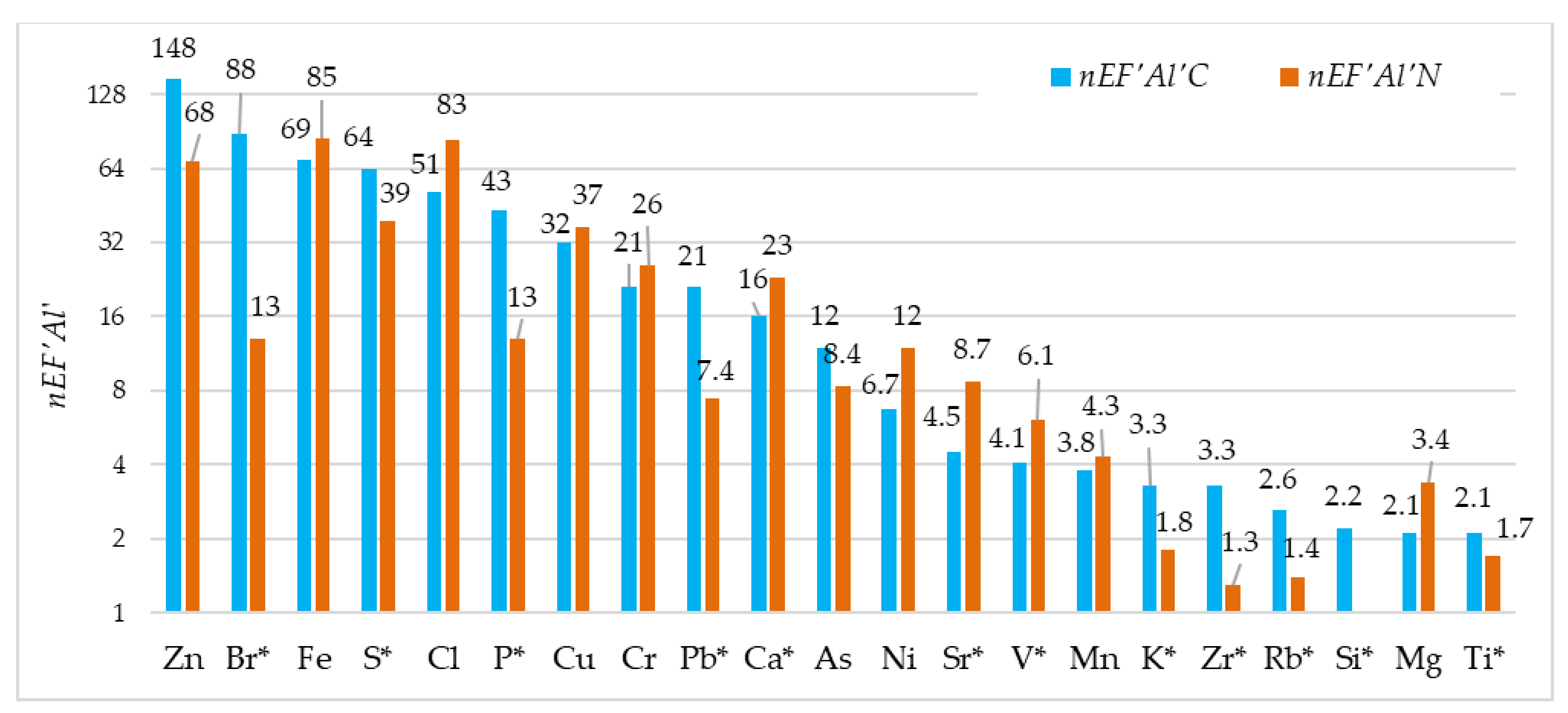
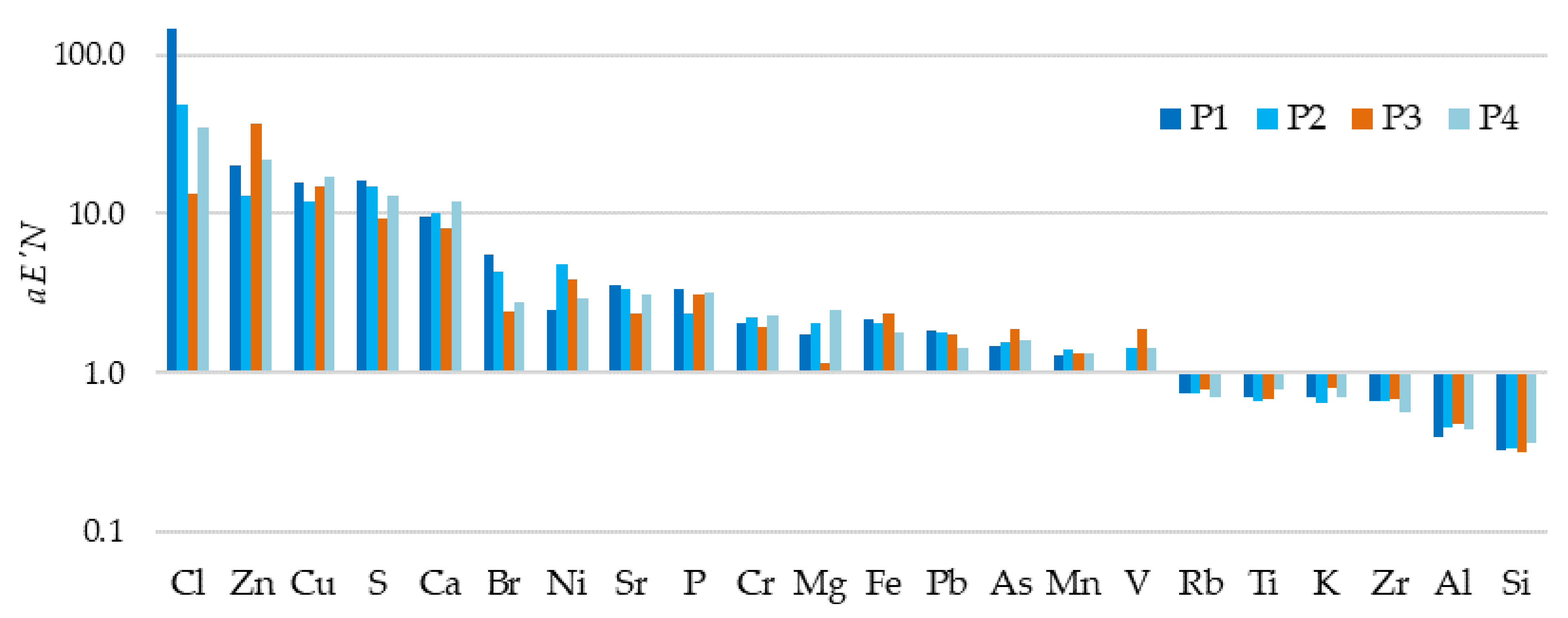




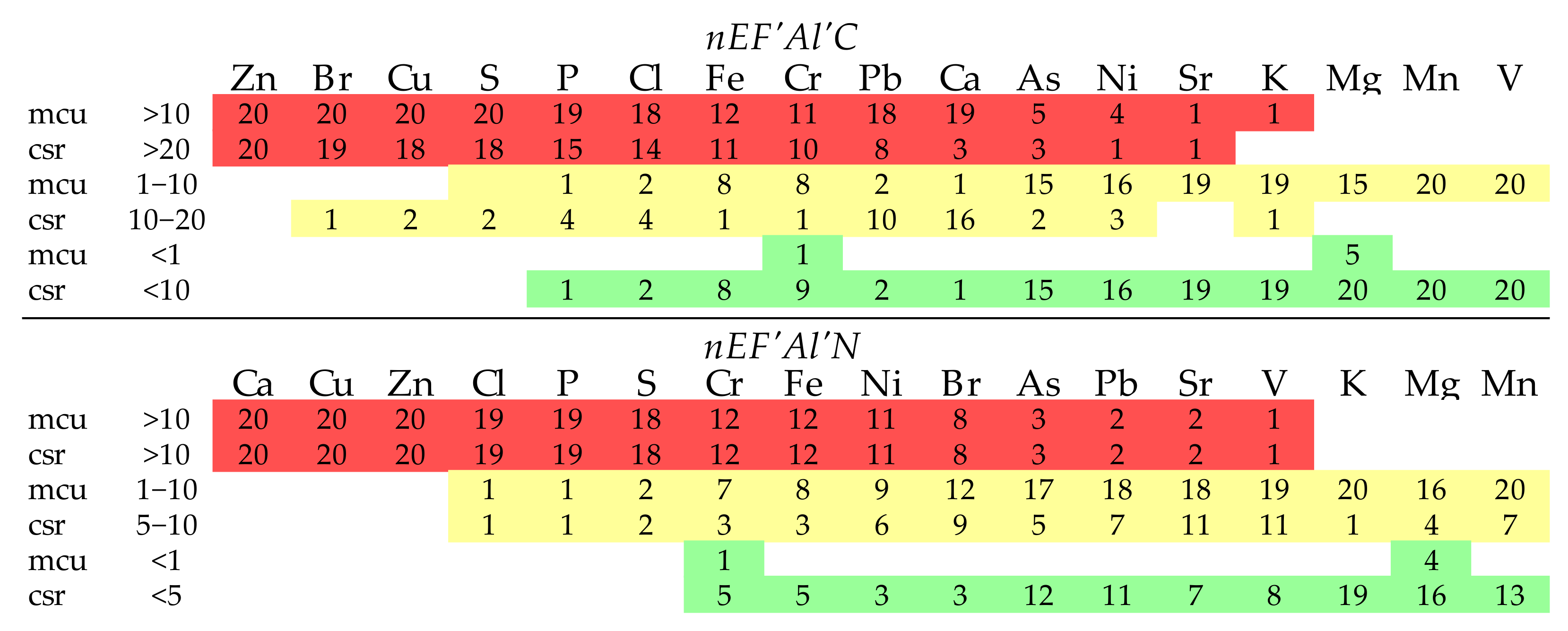
Publisher’s Note: MDPI stays neutral with regard to jurisdictional claims in published maps and institutional affiliations. |
© 2021 by the authors. Licensee MDPI, Basel, Switzerland. This article is an open access article distributed under the terms and conditions of the Creative Commons Attribution (CC BY) license (https://creativecommons.org/licenses/by/4.0/).
Share and Cite
Rapalis, P.; Zinkutė, R.; Lazareva, N.; Suzdalev, S.; Taraškevičius, R. Geochemistry of the Dust Collected by Passive Samplers as a Tool for Search of Pollution Sources: The Case of Klaipėda Port, Lithuania. Appl. Sci. 2021, 11, 11157. https://doi.org/10.3390/app112311157
Rapalis P, Zinkutė R, Lazareva N, Suzdalev S, Taraškevičius R. Geochemistry of the Dust Collected by Passive Samplers as a Tool for Search of Pollution Sources: The Case of Klaipėda Port, Lithuania. Applied Sciences. 2021; 11(23):11157. https://doi.org/10.3390/app112311157
Chicago/Turabian StyleRapalis, Paulius, Rimantė Zinkutė, Nadežda Lazareva, Sergej Suzdalev, and Ričardas Taraškevičius. 2021. "Geochemistry of the Dust Collected by Passive Samplers as a Tool for Search of Pollution Sources: The Case of Klaipėda Port, Lithuania" Applied Sciences 11, no. 23: 11157. https://doi.org/10.3390/app112311157
APA StyleRapalis, P., Zinkutė, R., Lazareva, N., Suzdalev, S., & Taraškevičius, R. (2021). Geochemistry of the Dust Collected by Passive Samplers as a Tool for Search of Pollution Sources: The Case of Klaipėda Port, Lithuania. Applied Sciences, 11(23), 11157. https://doi.org/10.3390/app112311157







